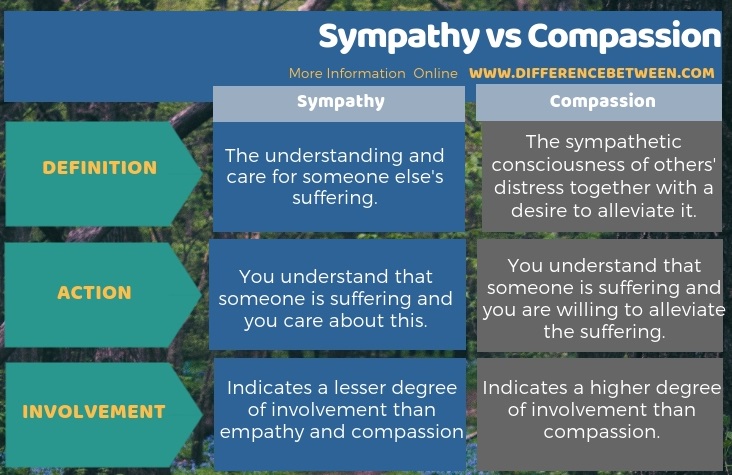The key difference between sympathy and compassion is that the sympathy means that you can understand what another person is going through whereas compassion is the willingness to relieve the suffering of another.
Pity, empathy, sympathy and compassion are words that indicate our reaction to the plight of others. Most of us tend to use these words interchangeably. However, these words have distinct meanings and are not synonymous with each other. Compassion indicates a higher degree of involvement with the plight of others than sympathy.
CONTENTS
1. Overview and Key Difference
2. What is Sympathy
3. What is Compassion
4. Side by Side Comparison – Sympathy vs Compassion in Tabular Form
6. Summary
What is Sympathy?
Sympathy refers to the feelings of sorrow and pity for someone else’s misfortune. To be more specific, it understands the distress or need of another. We often confuse sympathy with empathy. In empathy, you viscerally feel what another person is feeling. But, in sympathy, you are not experiencing another person’s feelings – you merely understand what that person is going through. For example, if a parent of one of your friends passes away, you might not actually feel the emotions your friend is going through. However, you can sympathize with him or her, i.e., you can understand that your friend is feeling sad and desolate.

Figure 01: Sympathy Card
This is why send sympathy cards when someone loses a loved one. A sympathy card indicates that you understand that he is suffering although you may not feel the same pain as you. In other words, this indicates that you care about his or her friend’s suffering.
What is Compassion?
Compassion is the sympathetic consciousness of others’ distress together with a desire to alleviate it. Thus, compassion takes sympathy a step further. When you are compassionate, in addition to recognizing a person’s suffering (sympathy) or feeling a person’s suffering (empathy), you will feel a strong compulsion to ease the suffering of that person. For example, you may see a beggar child on the street; you’ll recognize that the child is in need of help and then act towards helping that child. Here, the first act is understanding the child’s situation –this can be dubbed as sympathy. However, when you are compassionate, you’ll automatically feel the desire to alleviate the suffering of the child. This willingness to act in order to ease the suffering of another is the main difference between sympathy and compassion.

Compassion is associated with qualities such as patience, wisdom, kindness and perseverance. It is also often the main component of altruism. You can define an act of compassion by its helpfulness.
What is the Difference Between Sympathy and Compassion?
Sympathy is understanding and care for someone else’s suffering whereas compassion is the sympathetic consciousness of others’ distress together with a desire to alleviate it. This is the key difference between sympathy and compassion. That is, in sympathy, you understand that someone is suffering and you care about this. However, in compassion, you go a step further; you understand that someone is suffering and you are willing to alleviate the suffering. Thus, the degree of involvement indicates the difference between sympathy and compassion. The compassion indicates a higher degree of involvement than sympathy.

Summary – Sympathy vs Compassion
Sympathy and compassion are two words that indicate our reactions to the plight of others. The key difference between sympathy and compassion is that when you feel sympathy, you understand what another person is feeling whereas when you feel compassion, you understand his suffering and is willing to relive this suffering.
Image Courtesy:
1.”6993914211″ by June Campbell (CC BY-SA 2.0) via Flickr
2.”790616″ (Public Domain) via pixhere
ncG1vNJzZmivp6x7pbXFn5yrnZ6YsqOx07CcnqZemLyue8OinZ%2Bdopq7pLGMm5ytr5Wau26%2F2KanmqyYrnqiusNmmqiloJbAtLXOp2Y%3D